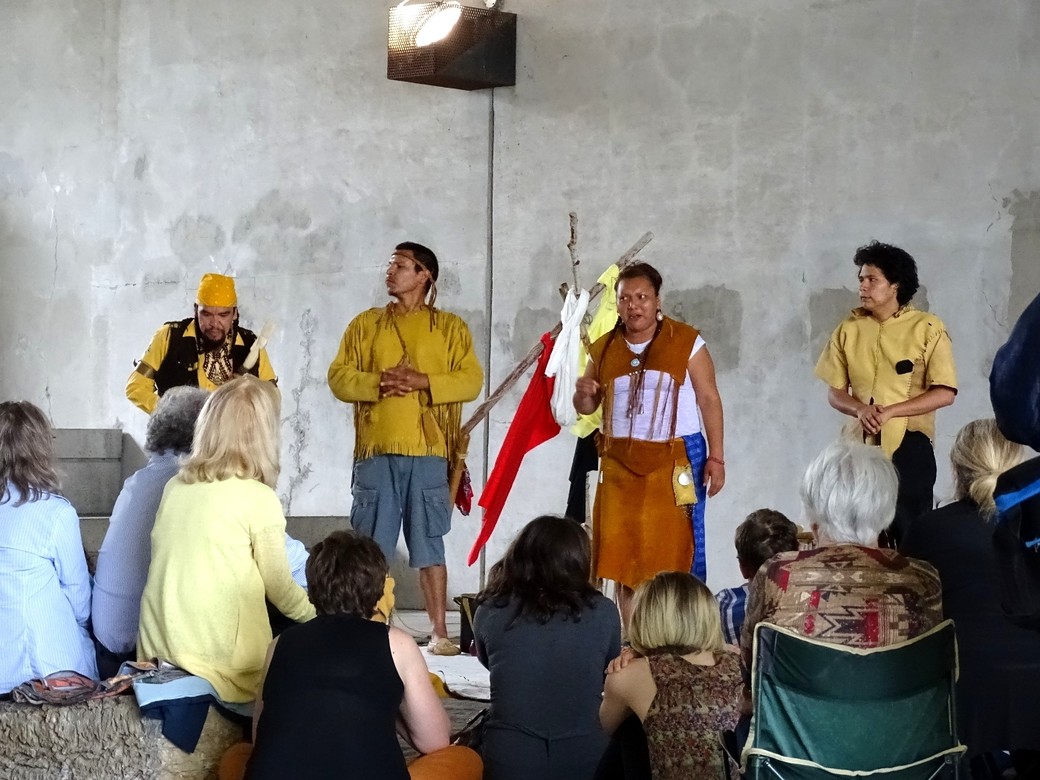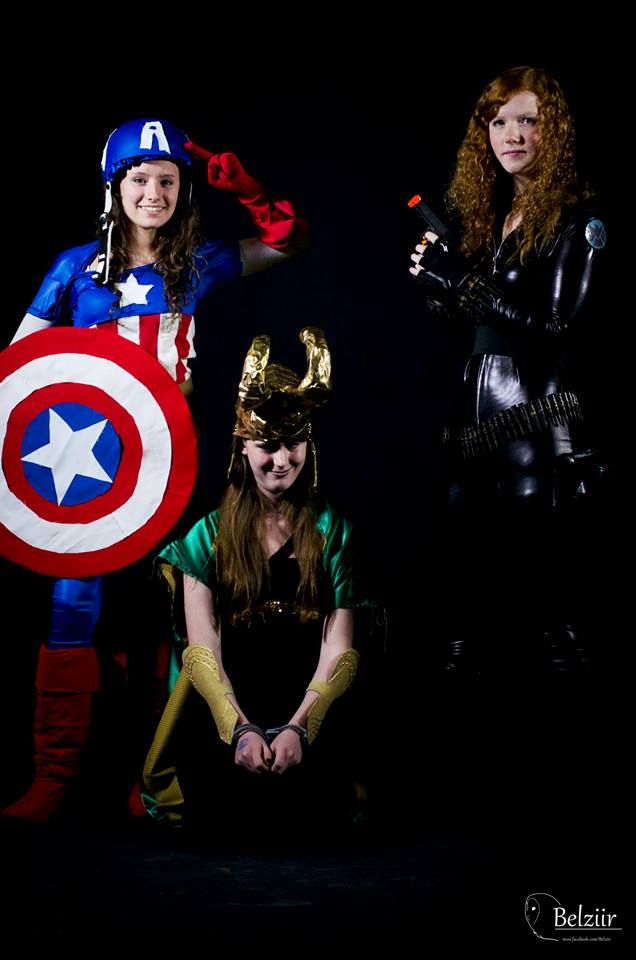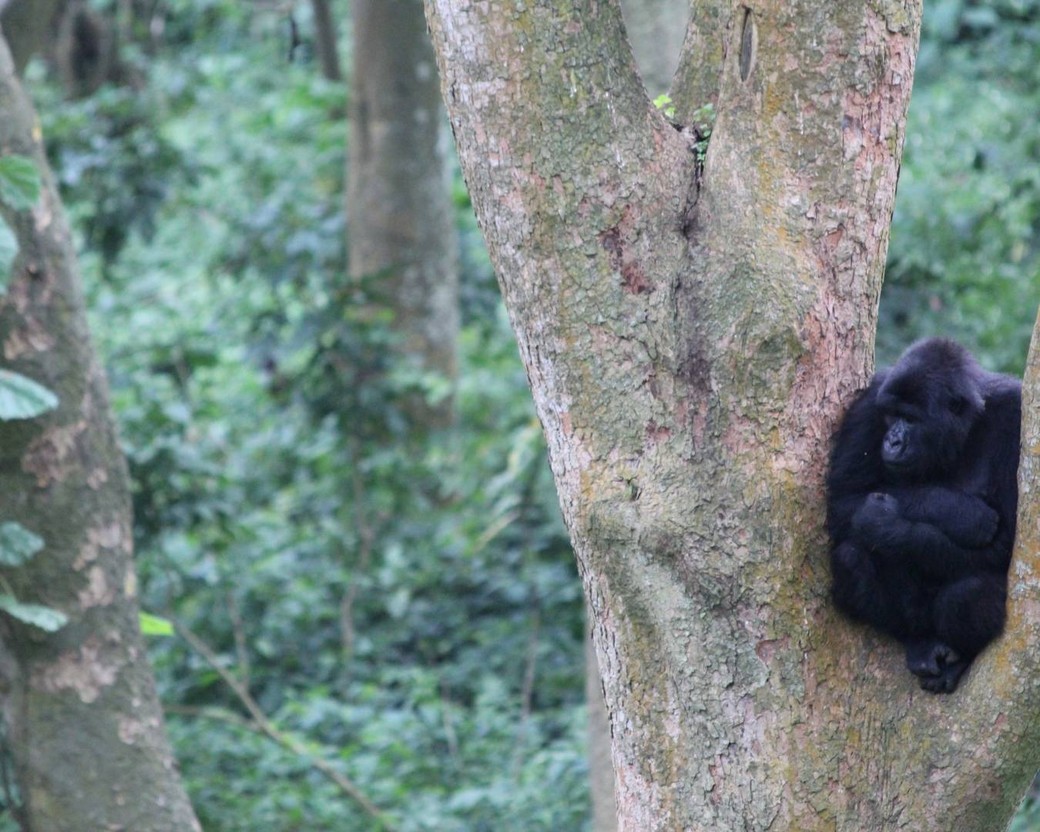
Native History with Pulse: Inspiring Journey of Thousand Years
Global Savages represent the members of the Anishnaabeg family: Debajehmud, Chibiabos, mother Sky Woman and Mudjeekwis (left to right). Photo courtesy of Ron Berti.
Have you heard the rowing of canoes?

Because Global Savages were here to tell their 18,000 year-old story as a part of Canada’s Magnetic North Theater Festival that took place on the first week of June in Ottawa. Close to a hundred people, young and old, among them tourists and casual passers-by, gathered under the bridge near the Bytown Museum to view the performance.
It was just in time as Ottawa was preparing to celebrate the National Aboriginal Day on June 21. The holiday was overshadowed by the report of the Truth and Reconciliation Commission on residential schools in Canada. Nevertheless, Global Savages brought some light and hope.
Global Savages represent the members of the Anishnaabeg family: the Sky Woman and her three sons Mudjeekwis, Debajehmud and Chibiabos. In their stories, the family travels through thousands of years, through civilizations, to bring the wisdom of their elders – the Kahila teachings, lessons of preservation of humanity.
Kahila teaches people to be “gentle.” The gentle people cherish the Mother Earth that houses and feeds them, the Sun that gives the light, and the woman who begets life. The wisdom also teaches patience and reconciliation.
As the play begins, the family portrays their live on the Turtle Island, isolated from the world until strangers arrived on their land. Blue-eyed, dressed in different clothes, at first, the strangers were regarded as creatures from the higher, spiritual world.
The spiritual creatures, however, brought war, not peace. First, they fought each other. Then, they turned their spears against the natives. The strangers not only killed the indigenous people, but they tore out the hearts of the native families – their children. The children were sent to residential schools, where they were supposed to learn the Western language and manners.

Children’s separation from their families, and what it meant for their parents, was well acted out by the Sky Woman. Her dramatic narration about disconnection of children with their culture and language finishes with long, loud wailing.
The recent report by the Truth and Reconciliation Commission (TRC) revealed that there were 130 church-run, government-funded schools across Canada. In these schools, 150,000 First Nation, Métis and Inuit students suffered abuse and harassment, and many – faced death. Close to 6,000 children died in the walls of the residential schools.
Canadian government has always been slow to act. The last residential school closed in 1996. Prime Minister Stephen Harper apologized on behalf of the government of Canada and all Canadians for the colonial school system only in 2008. The TRC report came out only two decades later.
It’s doubtful that the 94 recommendations by the TRC will be acted on by the present government. One of the recommendations of the report is for the Pope to offer an apology to Aboriginal people. When the TRC study came out, the prime minister was meeting with Pope Francis in Vatican City. Mr. Harper didn’t ask the Pope to apologize.
However, not all victims of residential schools had a negative impact, says Joseph Osawabine, the actor who plays Debajehmud. His grandfather withstood the residential system. As the result, the grandfather learned to read and write, which later helped him to become a successful entrepreneur.
“He [the grandfather] understood the world in a different way because of this [residential school experience] as well. And he instilled working values in us, in this family,” Osawabine says.
Osawabine is now the artistic director of the Manitoulin Island’s Debajehmujig Storytellers Theater. His theater is the only professional theater company on the Indian reserve that has been open for more than three decades. It is a place where the local youth learn their heritage, connect with the community, and find inspiration.

“Our company gives youth a voice, we give them a sense of hope for the future,” Osawabine says.
One of the mandates of the theater is establishing connection with non-natives and introducing them to the version of the history that is not taught in the Canadian schools.
Many Canadians are glad to attend performances by the indigenous people. In Ottawa, the public who gathered under the bridge represented mostly non-natives.
Andrée Chartier was one of the spectators. The show inspired Chartier to learn more about history of Aboriginal people. There is a rich history yet to be discovered, she says.
“We, non-natives, have to recognize how much good philosophy there is, and the way native people live that we can learn from,” Chartier says.
Chartier thinks it’s a good idea for everyone to have a native friend to learn from each other, and walk along together on the immense land that Canada is.
The artistic director Osawibine is positive about the future of his people. In spite of all tragedies and challenges, Osawibine says: “indigenous people of this land are still here.”
After the performance the Global Savages “boarded their canoe” to continue their journey of sharing the heritage of the Anishnaabeg family. The place under the bridge slowly cleared as people parted. Only the wailing of the mother Sky Woman kept resonating in the air of the empty space.
Have you heard her perchance?












